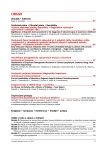Current possibilities of laboratory diagnosis heparin-induced trombocytopenia
Authors:
L. Slavík; G. Svobodová; J. Úlehlová; V. Krčová; A. Hluší; J. Procházková
Authors‘ workplace:
Hemato-onkologická klinika LF UP a FN Olomouc
Published in:
Transfuze Hematol. dnes,18, 2012, No. 2, p. 76-80.
Category:
Comprehensive Reports, Original Papers, Case Reports
Overview
Heparin-induced thrombocytopenia (HIT) represents a serious complication of heparin use. IgG antibodies binding platelet factor 4 (PF4) and heparin trigger the clinical manifestations of HIT. However, only a portion of the antibodies have the ability to activate platelets, and these can be identified by a platelet aggregation test (functional testing). Current methods – heparin-induced platelet aggregation (HIPA) and 14C-serotonin release assay (SRA) – are time-consuming and difficult if HIT is clinically suspected; therefore, numerous new methods have been developed recently. To determine HIT, impedance aggregometry using the Multiplate® analyzer (Verum Diagnostika, Munich, Germany) (MEA) as heparin-induced aggregation techniques and the Technozym HIT Ig ELISA test (Technoclone GmbH, Vienna, Austria) were used. The MEA method uses sensitization of donor platelets with patient plasma in the presence of heparin at a concentration of 0.5 IU/mL. MEA was performed in 300 μL of citrated whole blood with donor platelets, 150 μL of heparin (final concentration of 0.5; 100 IU/mL) and 150 μL of platelet-poor plasma (PPP) from the patient. Changes in aggregation were monitored for 20 minutes. The ELISA test results were evaluated as negative for OD <0.500 and positive for OD> 0.500 according to the manufacturer’s diagnostic setup. We examined 65 patients at a clinically intermediate and higher risk of HIT according to the 4T score. All samples were examined by the ELISA test and MEA, with positive samples being further confirmed by high-concentration heparin. In the studied group, we demonstrated that MEA has sufficient sensitivity and higher specificity. In the group of patients, there were 7.8% of positive results found by MEA as compared with 10.9% determined by ELISA. Unlike the ELISA methods of the same quality, MEA is more suitable for detecting platelet-activating HIT antibodies in practice.
Key words:
heparin-induced thrombocytopenia, functional test for HIT, ELISA determination of HIT
Sources
1. Králová S, Klodová D, Gumulec J, et al. Heparinem indukovaná trombocytopenie. Vnitř lék 2006; 52: 98–106.
2. Malý J, Pecka M, Dulíček P, et al. Jsou všechny nízkomolekulární hepariny stejné? Trombóza a hemostáza 1999; Malý J. & Pecka M., 24–25.
3. Novotný J, Konvičková L. Heparinem indukovaná trombocytopenie, Vnitř Lék 1998; 44: 282–287.
4. Albeiro L, Kimmerle S, Baumann A, et al. Rapid determination of anti-heparin/platelet factor 4 antibody titers in the diagnosis of heparin-induced thrombocytopenia, Am J Med 2003; 114: 528–536.
5. Andersson LO, Barrowcliffe TW, Holmer E, Johnson EA, Söderström G. Molecular weight dependency of the heparin potentiated inhibition of thrombin and activated factor X. Effect of heparin neutralization in plasma. Thromb Res 1979; 15: 531–41.
6. Stewart MW, Etches WS, Boshkov K, et al. Heparin-induced thrombocytopenia: an improved method of detection based on lumi-aggregometry. Brit J Haematol 1995; 91: 173–177.
7. Meyer O, Salama A, Pittet N et al. Rapid detection of heparin–induced platelet antibodies with particle gel immunoassay (ID–HPF4). Lancet 1999; 354: 1525–1526.
8. Pauzner R, Greinacher A, Selleng K, Althaus K, Shenkman B, Seligsohn U. False-positive tests for heparin-induced thrombocytopenia in patients with antiphospholipid syndrome and systemic lupus erythematosus. J Thromb Haemost 2009; 7: 1070–1074.
9. Polack B, Schved JF, Boneu B. Preanalytical recommendations of the ‘Groupe d’Etude sur l’Hemostase et la Thrombose’ (GEHT) for venous blood testing in hemostasis laboratories. Haemostasis 2001; 31: 61–68.
10. Tomer A, Masalunga C, Abshire TC. Determination of heparin-induced thrombocytopenia: A rapid flow cytometric assay for direct demonstration of antibody - mediated platelet activation. Am J Hematol 1999; 61: 53–61.
11. Elalamy I, Galea V, Hatmi M, Gerotziafas GT. Heparin-induced multiple electrode aggregometry: a potential tool for improvement of heparin-induced thrombocytopenia diagnosis, J Thromb Haemost 2009; 7: 1932 – 1934.
12. Morel-Kopp MC, Aboud M, Tan CW, Kulathilake C, Ward C. Whole blood impedance aggregometry detects heparin-induced thrombocytopenia antibodies, Thromb Res 2010; 125: 234–239.
13. Walenga JM, Jeske WP, Wood JJ, et al. Laboratory tests for heparin-induced thrombocytopenia: a multicenter study. Semin Hematol 1999; 36: 22–28.
14. Greinacher A, Levy JH. HIT happens: diagnosing and evaluating the patient with heparin-induced thrombocytopenia. Anesth Analg 2008; 107: 356–358.
15. Warkentin TE. Heparin-induced thrombocytopenia: pathogenesis and management. Br J Haematol 2003; 121: 535–55.
16. Kelton JG, Warkentin TE. Diagnosis of heparin–induced thrombocytopenia, still a journey, not yet a destination. Am J Clin Pathol 1995; 104: 611–613.
17. Levy-Toledano S, Gallet, C, Nadal F, et al. Phosphorylation and dephosphorylation mechanism in platelet function a tightly regulated balance. Thromb Haemost 1997; 78: 226–227.
18. Selleng S, Malowsky B, Itterman T, et al. Incidence and clinical relevance of anti-platelet factor 4/heparin antibodies before cardiac surgery, Am Heart J 2010; 160: 362–369.
Labels
Haematology Internal medicine Clinical oncologyArticle was published in
Transfusion and Haematology Today

2012 Issue 2
Most read in this issue
- Current possibilities of laboratory diagnosis heparin-induced trombocytopenia
- n 18-year old Female with a History of Collapse – Case Report
- Significance of hepcidin level assessment in the diagnosis of selected types of anaemia in childhood
- Early molecular response evaluation after 3 months of imatinib therapy in patients with chronic myeloid leukemia can contribute to estimation of prognosis – single centre experience
